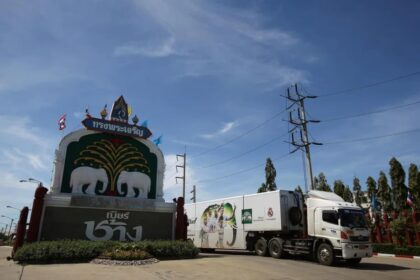A rapid push to support household spending
Indonesia has unveiled a new stimulus drive that targets two pressure points in the economy, household budgets and youth employment. Authorities will distribute 30 trillion rupiah in cash aid, about 1.8 billion dollars, to 35 million households. The payments are slated to begin as early as next week and continue through the end of the year. The aim is to deliver quick relief to families, support consumer demand in the final quarter, and help steady growth after a turbulent summer.
- A rapid push to support household spending
- Why the government is handing out cash now
- Who will receive the money and how it might be used
- Internship expansion aims to bridge the jobs gap
- Holiday travel tax relief and consumer spending
- Can these moves lift growth toward the 8 percent target
- How this package compares with the September measures
- Risks, trade offs and what to watch
- What to Know
Beyond cash transfers, the government is expanding a paid internship initiative that began in September, taking the total number of placements to 100,000 university graduates, up from an initial plan for 20,000. Officials have earmarked about 1.4 trillion rupiah to finance the additional 80,000 placements. To encourage holiday travel and spending, Finance Ministry regulations specify that the state will cover 6 percent of the 11 percent value added tax on economy class domestic air fares for trips between December 22 and January 10. The package builds on a nearly 1 billion dollar set of measures announced in September that included food assistance, temporary construction jobs, and the internship launch. For reference, 1 dollar equals 16,575 rupiah.
The new steps follow deadly protests in August and September that analysts linked to rising inequality and a shortage of quality jobs, even as headline growth has held near 5 percent since the pandemic. President Prabowo Subianto has pledged to lift growth to 8 percent by 2029. The latest package pairs immediate relief for households with a larger bridge from campus to full time work for young graduates.
Why the government is handing out cash now
Private consumption makes up roughly half of Indonesia’s output, so a well timed boost to purchasing power can influence growth. When families have more to spend, shops and street markets see higher turnover, transport services gain passengers, and small service providers book more work. Unlike large infrastructure projects, cash support arrives quickly and can be tapered once conditions improve. The calendar matters too, since the fourth quarter often brings higher spending linked to travel, community events, and school needs.
Design shapes impact. Transfers focused on lower income households tend to generate a stronger response because these families usually spend a larger share of each rupiah on essentials. Combining cash with food assistance and temporary jobs steadies budgets and can keep vulnerable households engaged in work and schooling. Timed before the holiday period, payments can help prevent a dip in demand when prices for travel and festivities often rise.
How cash transfers work through the economy
A simple chain describes the effect. A family receives money and uses it for rice, cooking fuel, transport, rent, mobile data, or basic repairs. Local stalls and retailers see more customers. Suppliers order additional stock from farms and factories. Transport operators add more trips. That activity supports wages and freelance income. Because the support is temporary, households may save part of it or repay debt, yet the share that goes straight into daily purchases is often large and fast acting.
Who will receive the money and how it might be used
Authorities plan to reach more than 35 million families, which equates to roughly 140 million people based on average household sizes. Distribution is slated to start as early as next week and run through year end. Indonesia has experience delivering social assistance at scale, and existing beneficiary lists can accelerate the rollout while lowering administrative costs.
A rough calculation helps frame the magnitude. If all 30 trillion rupiah flowed evenly to 35 million households, the average transfer would be about 857,000 rupiah per family, which is close to 52 dollars at the current exchange rate. Actual amounts can differ by region, eligibility, and program rules, so this is only a ballpark guide to scale rather than a precise per household payment.
Potential uses for the cash and near term effects
Families commonly direct cash support to food staples, cooking oil and fuel, electricity, rent, school supplies, medical needs, and transport. The boost often shows up in supermarket and traditional market sales, street vendor turnover, ride hailing trips, and intercity buses. Local governments can see higher market fees and transit volumes, while small firms benefit from faster inventory turnover at year end, allowing them to restock for the new year.
Internship expansion aims to bridge the jobs gap
The paid internship program will place 100,000 recent university graduates with host organizations across the country. Coordinating Minister for Economic Affairs Airlangga Hartarto outlined the expansion at a government briefing, and officials set aside about 1.4 trillion rupiah to finance 80,000 additional placements beyond the first 20,000 in the original plan. The goal is to provide structured experience, exposure to real projects, and a path into permanent roles that match graduate skills to labor market needs.
This approach addresses a common hurdle for young job seekers, the experience requirement for entry level roles. Internships provide references, networks, and workplace skills that university alone may not deliver, from data tools to client communication. For employers, government support lowers onboarding costs and expands the candidate pool. Guardrails are important so that internships add real training value and do not substitute for regular jobs in disguise. State Secretariat Minister Prasetyo Hadi has highlighted funding for the expansion to ensure placements are paid.
What success will look like
Key signals of success include a high share of interns moving into full time roles within a few months, feedback from host companies on productivity, and a spread of placements beyond Jakarta and other big cities. Transparent reporting on completion rates, stipend levels, and conversion to permanent jobs will help the public assess whether the program is meeting its stated goals.
Holiday travel tax relief and consumer spending
Covering 6 percent of the 11 percent value added tax on economy class domestic air fares cuts ticket prices for travel between December 22 and January 10. That period captures Christmas and New Year journeys when Indonesians travel for family gatherings and tourism. The step complements earlier travel discounts designed to keep planes full and support destination economies during the holiday season.
Lower air fares can stimulate spending across the tourism chain. Hotels, homestays, restaurants, transport services, and souvenir shops benefit when more visitors arrive. Airlines may achieve better load factors while airports see higher passenger flow. If fuel costs and seat capacity remain steady, travelers should see a visible difference in final prices on eligible routes, which can lift domestic tourism revenues.
Can these moves lift growth toward the 8 percent target
In dollar terms, 30 trillion rupiah is about 1.8 billion, which equals roughly 0.13 percent of Indonesia’s gross domestic product. That is modest at the national level but meaningful for the families involved. Together with the nearly 1 billion dollar package in September, total support in the second half of the year remains a small share of output, yet it lands when household spending naturally rises. That timing can provide a noticeable lift to fourth quarter momentum.
Reaching 8 percent growth would require sustained investment, higher productivity, and broader job creation across manufacturing, services, and agriculture. Simpler permits, better logistics, reliable energy supply, and skills programs can help unlock that path. The internship expansion fits the human capital agenda by easing the school to work transition, while cash transfers are designed to prevent a slowdown in demand as reforms progress.
How this package compares with the September measures
The September package emphasized food assistance, temporary jobs in construction, and the first wave of paid internships. The latest steps keep the focus on two fronts, immediate support for purchasing power and a larger bridge for graduates into the labor market. Scaling up a program in phases can improve targeting and training design as managers learn from early placements.
Data from the initial 20,000 internships can guide the next 80,000. For example, sectors and regions that showed strong absorption can receive more placements, while areas with weak uptake can adjust training content or recruitment. The travel tax relief adds a targeted boost to a sector that spreads gains across many local economies.
Risks, trade offs and what to watch
Short term cash support can add pressure to prices if supply is tight, especially for rice, poultry, and transport. Authorities will monitor inflation to keep it within target. Exchange rate swings can also filter into food and fuel costs where imports are part of the supply chain, which makes coordinated policy important.
Budget discipline will shape how long and how far support can run. Indonesia manages public debt and deficits with legal limits to preserve stability while funding social priorities. Effective procurement, digital payment channels, and fraud checks can stretch funds and improve trust in delivery.
Execution will determine impact. The pace of disbursement, the accuracy of beneficiary lists, and the ease of payment collection will matter more than announcements. For the internship track, the share of placements that convert into jobs, the distribution beyond major cities, and feedback from host firms and interns will be key signs of effectiveness.
What to Know
- Government will send 30 trillion rupiah in cash aid to 35 million households from next week through year end.
- Paid internship program expands to 100,000 graduates, with about 1.4 trillion rupiah funding the additional 80,000 placements.
- State will cover 6 percent of the 11 percent VAT on economy class domestic air fares for travel between December 22 and January 10.
- Measures build on a nearly 1 billion dollar September package with food aid, temporary construction jobs, and the internship launch.
- Growth has hovered near 5 percent since the pandemic, while protests in August and September reflected job and inequality concerns.
- President Prabowo aims for 8 percent growth by 2029, pairing short term support with efforts to build skills and investment.
- Exchange rate reference used by officials, 1 dollar equals 16,575 rupiah.
- Policies are intended to boost holiday spending, stabilize household budgets, and improve youth employment outcomes.












